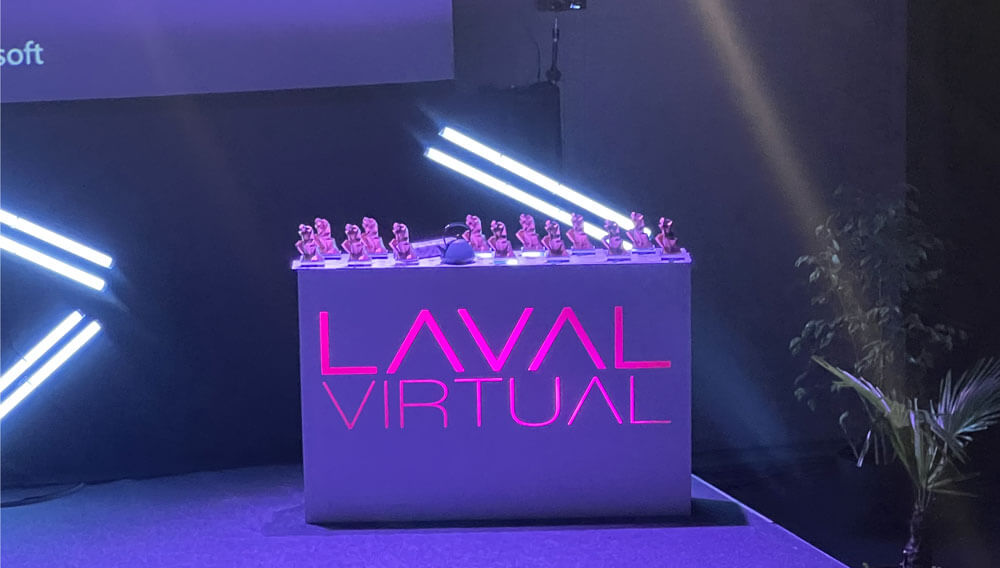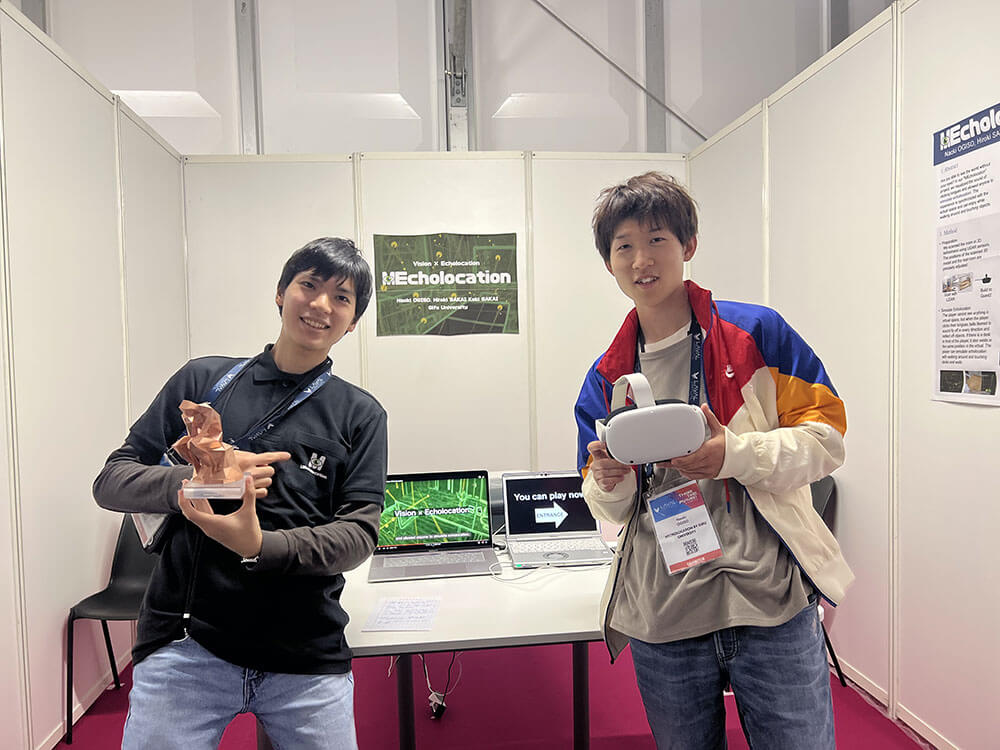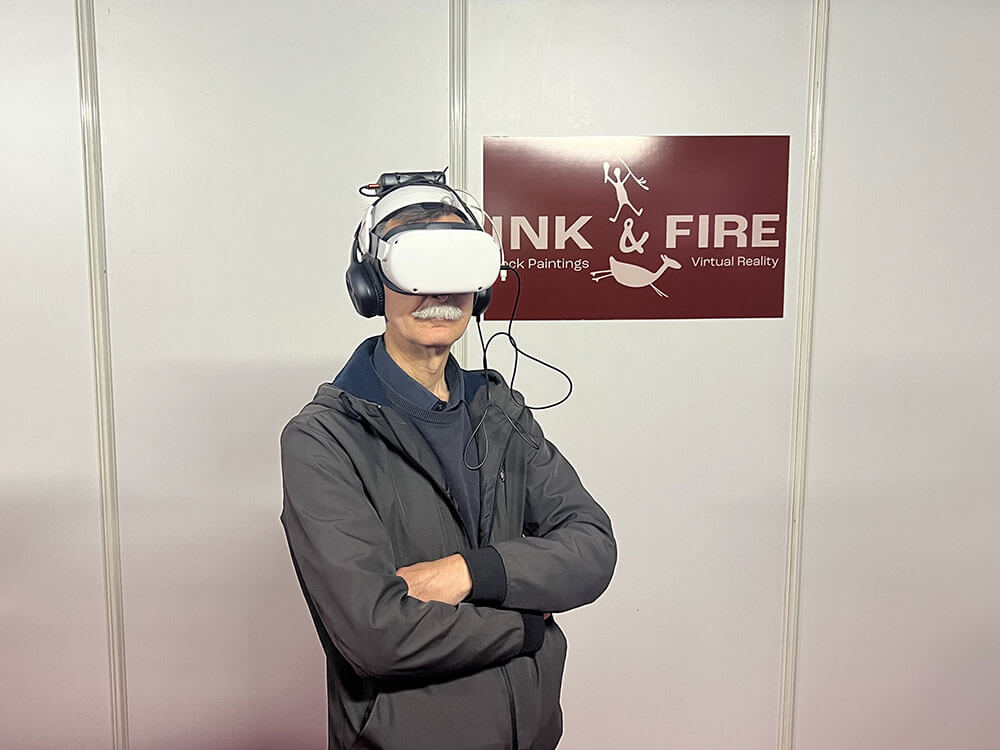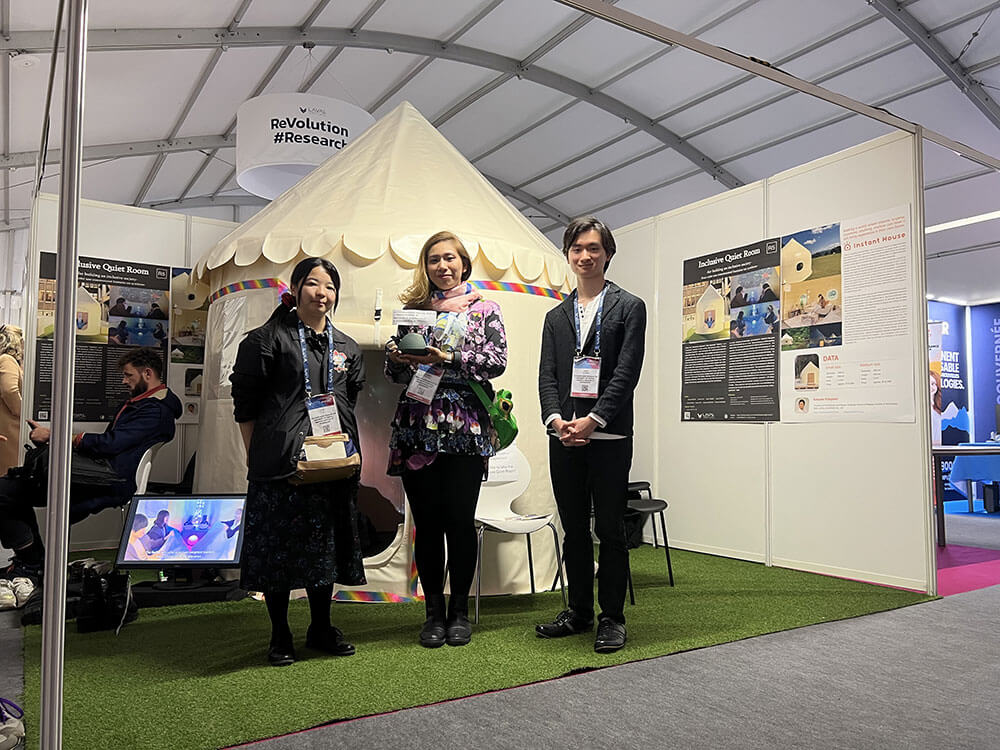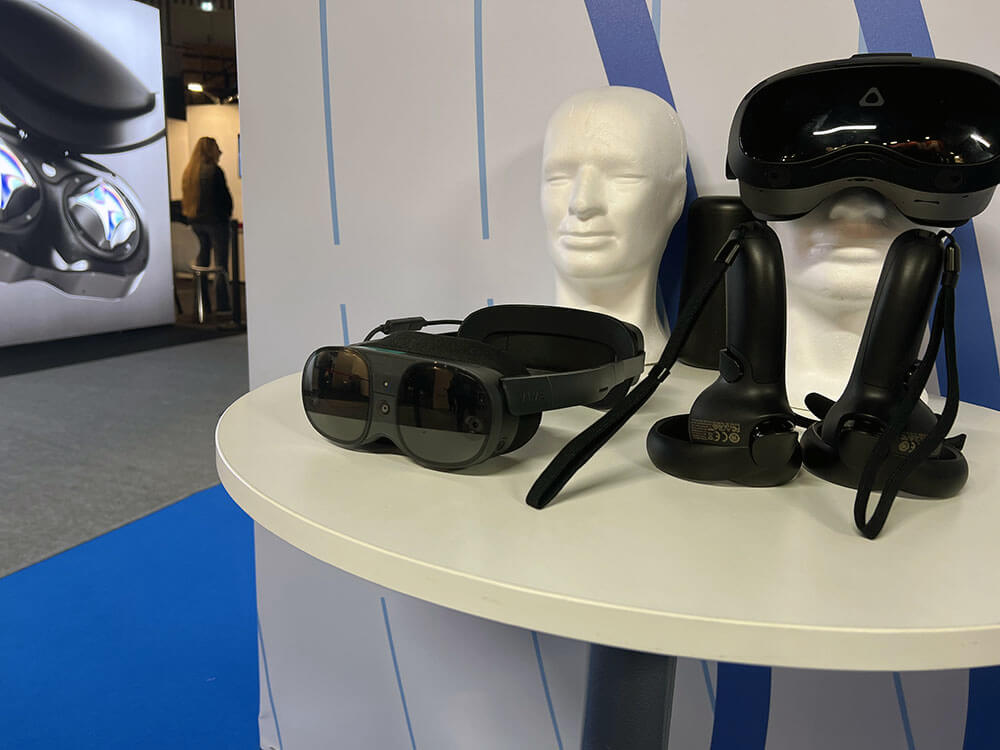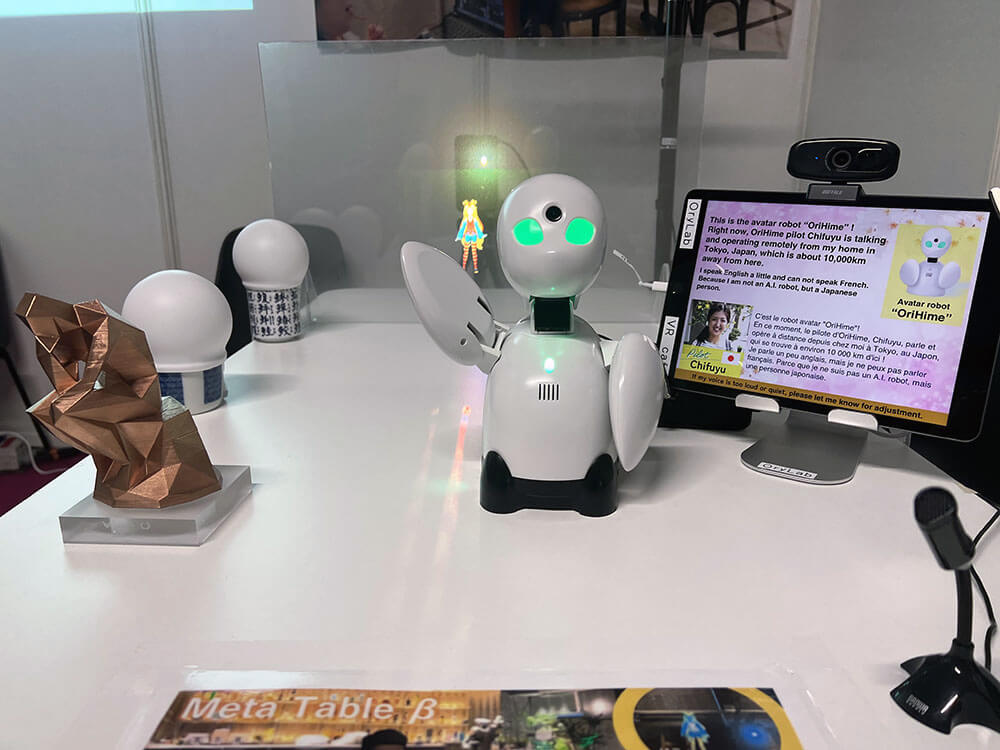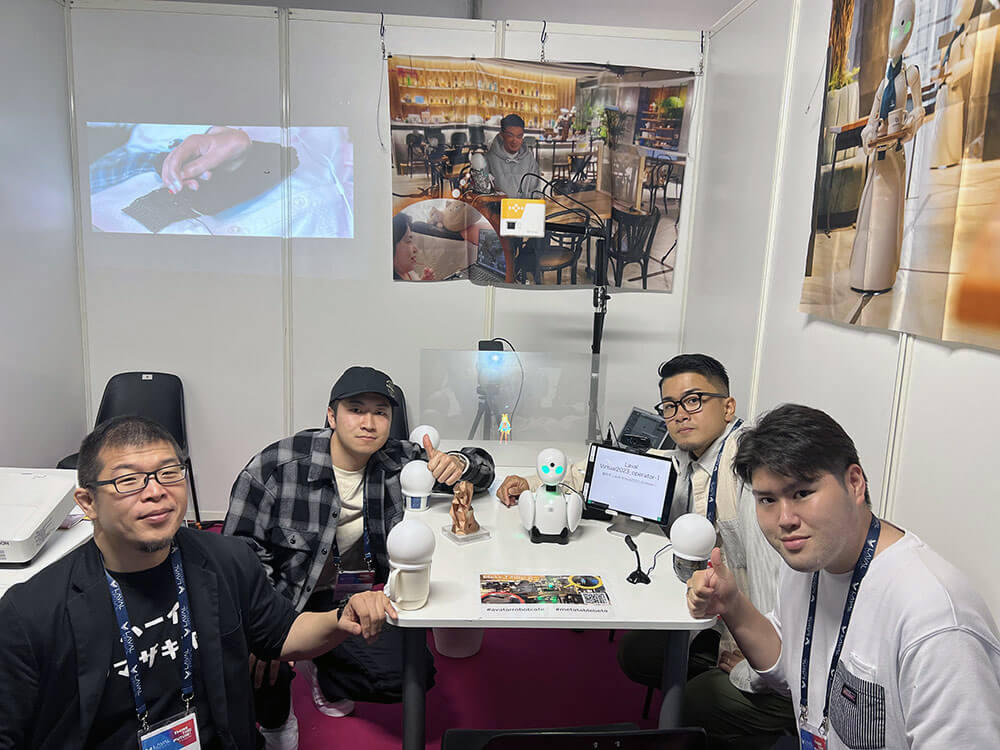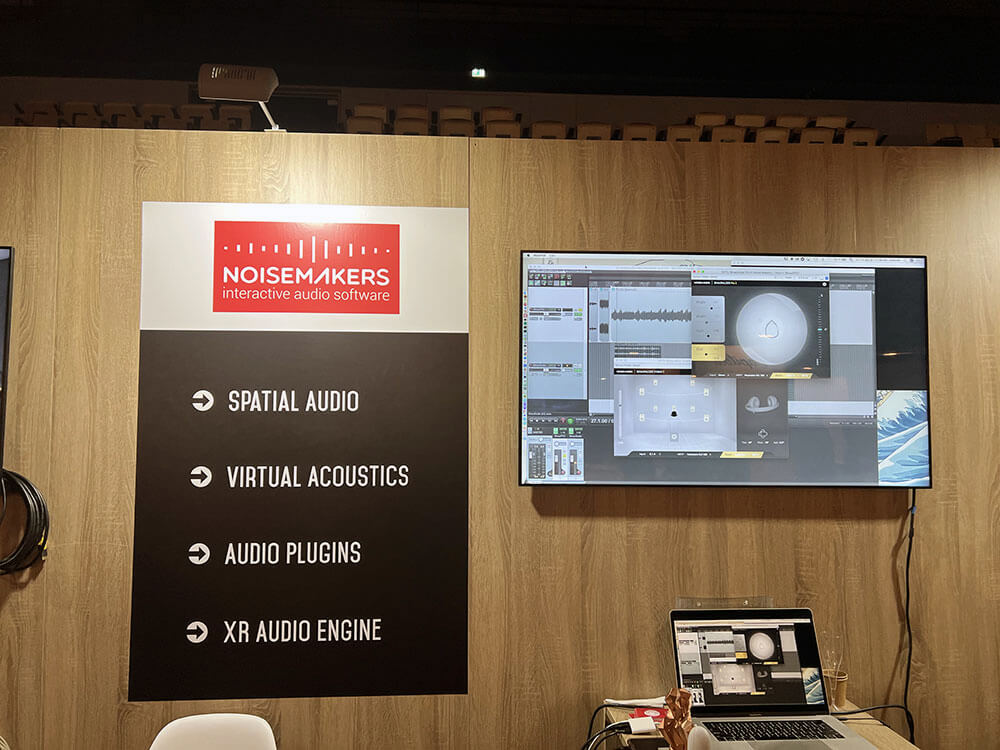Laval Virtual is an annual international festival dedicated to VR and AR held in Laval, France. This year marks the festival’s 25th anniversary as a forum for industry, academic, entertainment professionals, and other participants active in the VR and AR fields.
Each part of this review series will explore different aspects of the event. In this fourth article, I highlight the winners of the 25th Laval Virtual Awards.
- 1 What are the Laval Virtual Awards?
- 2 ReVolution #Research: “MEcholocation” by Gifu University
- 3 ReVolution #Experiences: “Ink & Fire” by Studio KwO XR & VRXP
- 4 ReVolution #Students: “The Unclaimed Masterpiece” by Arts et Métiers students
- 5 SIGGRAPH AWARD: “Inclusive Quiet Room” by the University of Tokyo and the Nagoya Institute of Technology
- 6 LV Awards, Hardware: HTC VIVE XR Élite
- 7 LV Awards, XR for a Cause: “Meta Table β” by Kanagawa Institute of Technology and OryLab Inc.
- 8 LV Awards, Developer & Authoring Tools: “Virtual Acoustic Mixer” by Noise Makers – Destination Rennes
- 9 Conclusion
What are the Laval Virtual Awards?
Laval Virtual offers a variety of prizes, and the competition is divided into three categories.
The annual Laval Virtual ReVolution competitions shed light on innovation in the fields of VR and AR. Startups, production studios, developers, researchers and students showcase their cutting-edge projects and compete for awards in four categories: #Experience, #Research, #StartUp and #Student.
Each year, Laval Virtual announces an open call for entries before selecting the winners of the LV Awards. The awards showcase innovative extended reality (XR) solutions from around the world and the creative minds behind them. The contest considers all projects developed between January 2022 and April 2023.
During the festival, there is also a 30-hour “hackathon” where 10 participating teams compete to win.
ReVolution #Research: “MEcholocation” by Gifu University
The winning entry for the ReVolution #Research competition was “MEcholocation” by Gifu University, a VR project that explored the echoes of sound.
Are you able to see the world without your eyes? In our ‘MEcholocation’ project, we visualized the sound of clicking tongues and allowed anyone to simulate echolocation. The experience is synchronized with the actual space and can enjoy while walking around and touching objects.
— Explanation of the work on the official Laval Virtual website
Some animals, such as bats and dolphins, can use a biological sonar called echolocation. By emitting ultrasonic waves, they can identify an object’s location and size based on the reverberations. Similarly, some visually impaired people click their tongues to perceive space. Inspired by such skills, the “MEcholocation” project illustrates these sounds, allowing anyone to simulate echolocation in VR.
ReVolution #Experiences: “Ink & Fire” by Studio KwO XR & VRXP
For the ReVolution #Experiences competition, the winning entry was the “Ink & Fire” exhibition by Studio KwO XR & VRXP from Brazil.
The interactive exhibition Ink & Fire will take the visitor back in time, to the universe and art of the first inhabitants of the Americas. Presenting the most important group of rock paintings in Brazil for the first time in an immersive way to general audiences, the multimedia exhibition mixes virtual reality, augmented reality and photographs in an incredible dive into our past. The project brings the wealth of the Serra da Capivara National Park, democratizing access to this UNESCO World Heritage Site through cutting-edge technology.
— Explanation of the work on the official Laval Virtual website
This interactive virtual story begins in a museum. While standing in front of the cave murals on display, we are transported to the distant past. As the title implies, ink plays an important role in the story, and the VR scene allows us to take a handful of red ink and draw a cave mural of our own. Despite being set in an ancient era, the VR work’s interactive elements make it a realistic experience.
ReVolution #Students: “The Unclaimed Masterpiece” by Arts et Métiers students
The winning entry for the ReVolution #Students competition was “The Unclaimed Masterpiece” by a team of students from the Laval Institute of Arts et Métiers.
In this virtual reality experience, you play as a thief attempting to steal a rare painting generated by an artificial intelligence. You will face off against a sly butler named Alfred, who is controlled by the GPT-3.5 language model. Alfred has the ability to create very realistic responses and to lie in order to protect the painting. You will need to put your negotiation skills to the test to convince Alfred to help you in your mission. The mansion is full of surprises, and you will be able to experience a unique and exciting adventure in this fascinating virtual world.
— Explanation of the work on the official Laval Virtual website
The students created this project with the goal of designing a game that utilizes artificial intelligence (AI). As a fast-growing field, AI is becoming more and more integrated into everyday life. The Arts et Métiers students’ work utilizes a head-on approach and explores the possibilities of AI technology.
This project also won them an invitation to next year’s Interverse Virtual Reality Challenge (IVRC) student competition in Japan. Make sure to visit them if you are in the country!
SIGGRAPH AWARD: “Inclusive Quiet Room” by the University of Tokyo and the Nagoya Institute of Technology
The winner of the SIGGRAPH AWARD was “Inclusive Quiet Room” by the University of Tokyo and the Nagoya Institute of Technology. The winners are invited to Los Angeles for SIGGRAPH 2023, which will take place in August.
‘The Inclusive Quiet Room is a ‘quiet room’ that combines a space where people can calm their minds with visual and auditory expressions. These expressions are based on the creators’ experiences. It creates a digital rehabilitation experience using an instant house which is an easy to create enclosed space, snoezelen using colourful lights, immersive VR videos, relaxing music, soft cushions and thick blankets. We hope that visitors will be able to experience the process by which people with sensory sensitivities regain their calm.
— Explanation of the work on the official Laval Virtual website
The “Inclusive Quiet Room” provides a space for relaxation by letting you watch videos and snuggle up with a weighted blanket. Focused on calming the mind, this booth was invented by Professor Keisuke Kitagawa of the Nagoya Institute of Technology after he witnessed the anxiety and stress many were experiencing at the evacuation centers in the aftermath of the 2011 earthquake in Japan. Although the University of Tokyo and the Nagoya Institute of Technology initially had different starting points, their shared desire to help people made this collaboration possible.
LV Awards, Hardware: HTC VIVE XR Élite
Though there were many notable contenders in the hardware category, the winning product was the VIVE XR Elite headset by HTC VIVE.
I was amazed at the quality of the headset’s real-world images and the lightness of the system. The product allowed me to experience an intersection of reality and virtuality that I had never before experienced in the VR world. The view inside the headset reminded me of the picture book Harold and the Purple Crayon, where the protagonist, Harold, explores the scenes he draws in crayon.
The VIVE XR Elite’s display consists of two OLED panels, which provide extremely clear, high-resolution images. The headset’s design blocks outside light, enabling a more immersive experience. It also supports 6DoF tracking, which, used together with the controller and included base station, greatly improves hand tracking accuracy.
The VIVE XR Elite offers additional features for professionals, such as a wireless adapter that lets users move freely without having to worry about tripping over cables. The company also offers a distribution platform for VR applications and content.
LV Awards, XR for a Cause: “Meta Table β” by Kanagawa Institute of Technology and OryLab Inc.
The winning project of the XR for a Cause award was “Meta Table β,” developed by Kanagawa Institute of Technology and OryLab Inc.
“Meta Table β” enables people in remote locations to meet virtually in an avatar robot café. This space allows people with disabilities or those who otherwise find it difficult to go out to engage in remote work by using the avatar robot “OriHime,” which was created to eliminate all the “loneliness” in the world.
Currently, the café employs over 50 people with disabilities or who are experiencing social withdrawal. However, operating an avatar robot and serving customers in a café requires a high level of skill. Some employees are new to customer service or find it challenging to simultaneously operate an avatar robot and serve customers. In addition to the unfamiliar environment, another obstacle they face is trying to interpret customers’ emotions while communicating remotely. “Meta Table β” was developed to fill this communication gap. OriHime staff (called “Pilots”) operating the robot can understand the mood of the cafe with the support of AI. They can then reflect this mood to the customers using CG avatars that combine transparent displays and projection mapping.
Pictured above is the avatar robot waving at me. It is actually controlled remotely from Japan by the “pilot” Chifuyu-san. The robot’s actions, such as nodding and waving, can be controlled by a simple click of the mouse or tap on the iPad.
“Meta Table β” expands social participation opportunities for those who experience difficulties leaving the house, enabling them to engage with customers remotely.
Preceded by a lecture, “Meta Table β” was shown to the public for the first time at Laval Virtual Festival.
LV Awards, Developer & Authoring Tools: “Virtual Acoustic Mixer” by Noise Makers – Destination Rennes
The winner of the Developer & Authoring Tools award was the “Virtual Acoustic Mixer” developed by Noisemakers, a France-based acoustic software manufacturer.
The Virtual Acoustic Mixer (VAM) is an authoring tool for 3D audio provided by Noisemakers. Implemented in the Binauralizer Studio software, the tool allows users to create high-quality room effects in virtual environments.
Binauralizer Studio is a spatial audio plug-in (VST, AU, AAX) that allows users to convert surround mixes to binaural 3D audio for headphones. This conversion preserves the original multichannel tracks’ spatial information.
Highly regarded in the field of sound design, VAM enables more realistic 3D audio spaces and helps sound producers for music, films and games create inspiring content.
Conclusion
Though this article only touches on the winning projects, there were many other fascinating works that were nominated, as well. For those planning to visit Laval Virtual next year, I highly recommend seeking out all types of experiences at the festival.
In the next article, I will review some of the digital art exhibitions shown at Laval Virtual Festival 2023.
Edited by SASAnishiki
Translated by cpnnn
